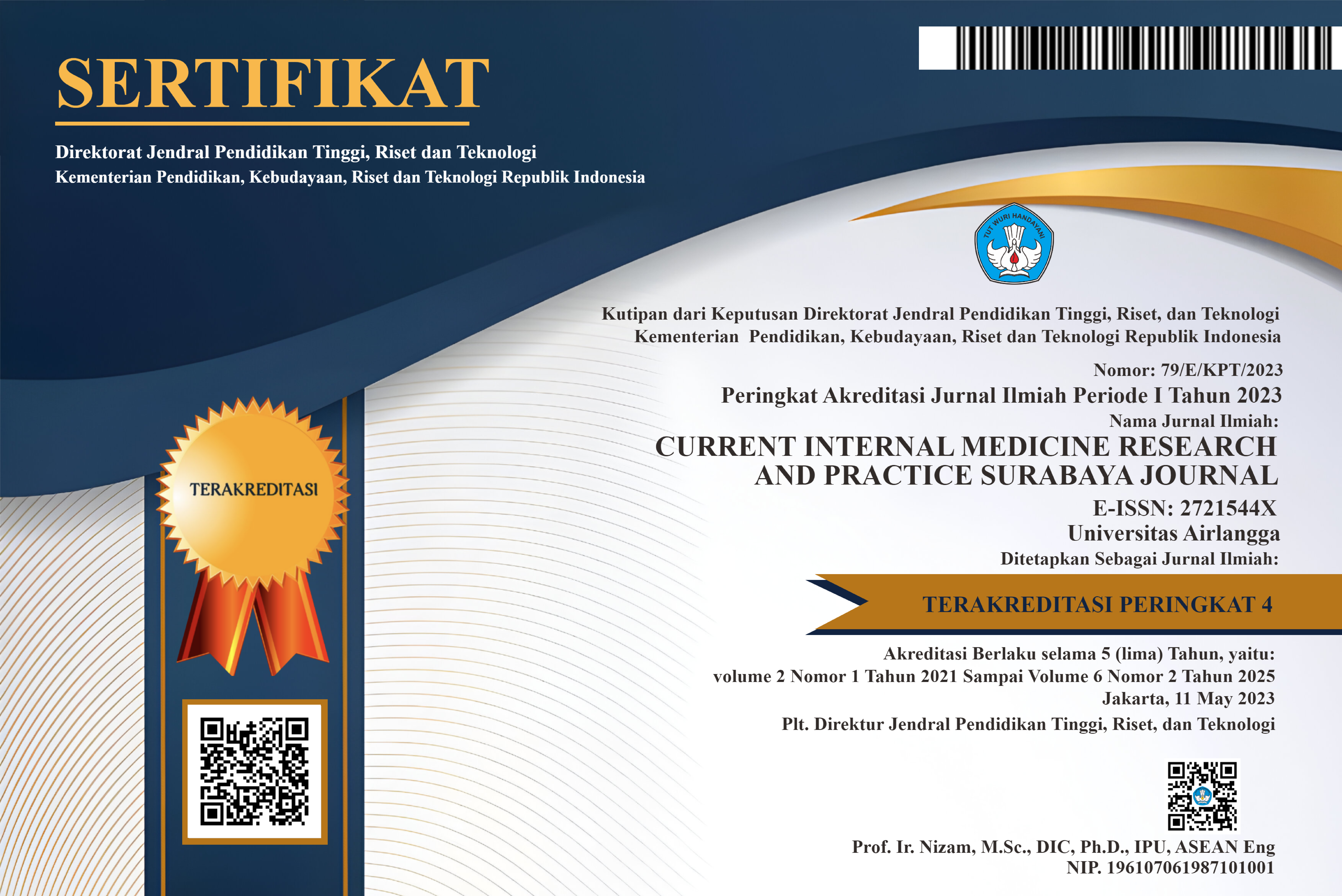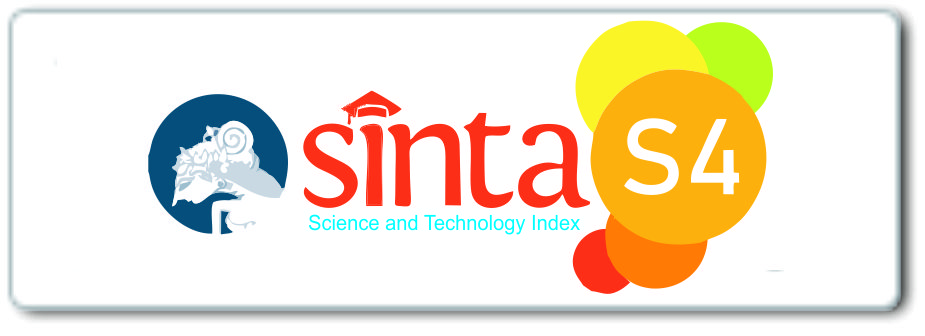Serum Serotonin Levels and the Severity Scores and Types of Delirium among Geriatric Patients in Denpasar, Indonesia
Downloads
Introduction: Delirium is an acute attention disorder that often occurs in elderly patients. The serotoninergic pathway is the main neurotransmitter pathway involved in the development of delirium. Serotonin, known as 5-hydroxythyramine (5-HT), affects mood, aggressiveness, cognition, depression, pressure, and stress in the brain environment. This may lead to the formation of hypoactive, hyperactive, or mixed delirium processes. This study utilized laboratory data with the aim of investigating whether serotonin levels have a correlation with severity score and delirium type in elderly individuals who experience delirium during hospitalization.
Methods: This study was conducted in the field of geriatrics at Prof. Dr. IGNG Ngoerah Central General Hospital, Denpasar, Indonesia, from April 2022 to October 2023. The sample was gathered consecutively, consisting of 62 hospitalized geriatric patients who suffered from delirium and were willing to participate by signing an informed consent. We excluded post-surgical patients and psychoactive drug users. The data were collected using the Memorial Delirium Assessment Scale (MDAS), the Confusion Assessment Method (CAM), and a serum serotonin test. This study used bivariate analysis, the Kruskal-Wallis test, and Spearman’s correlation (p<0.05).
Results: A total sample of 62 individuals was required. There was a significant difference in the mean serotonin levels among different types of delirium (p<0.05). Out of all the documented cases, hypoactive delirium was the most frequently observed (64.5%). Most of the elderly patients experienced severe delirium (54.8%). Serotonin levels had a significantly negative correlation with the MDAS scores (r=-0.95; p<0.001).
Conclusion: The research findings indicate a correlation between lower serotonin levels and higher MDAS scores, and vice versa.
Highlights:
1. This study attempted to determine the relationship between serum serotonin levels and delirium severity scores among geriatric patients in Indonesia.
2. There was a significant difference in the mean serotonin levels among elderly individuals with hypoactive, hyperactive, and mixed types of delirium.
Ahmed S, Leurent B, Sampson EL (2014). Risk factors for incident delirium among older people in acute hospital medical units: A systematic review and meta-analysis. Age and Ageing 43(3): 326–333. doi: 10.1093/ageing/afu022.
Attard A, Ranjith G, Taylor D (2008). Delirium and its treatment. CNS Drugs 22(8): 631–644. doi: 10.2165/00023210-200822080-00002.
Babacan-Yildiz G (2018). Approach to the elderly patient with delirium: A neurologist’s perspective. In: Delirium in Elderly Patients (A Isik, G Grossberg eds). Springer International Publishing, Cham. doi: 10.1007/978-3-319-65239-9_7.
Boettger S, Breitbart W (2011). Phenomenology of the subtypes of delirium: Phenomenological differences between hyperactive and hypoactive delirium. Palliative and Supportive Care 9(2): 129–135. doi: 10.1017/S1478951510000672.
Breitbart W, Rosenfeld B, Roth A, Smith MJ, Cohen K, et al. (1997). The memorial delirium assessment scale. Journal of Pain and Symptom Management 13(3): 128–137. doi: 10.1016/S0885-3924(96)00316-8.
Charnay Y, Leger L (2010). Brain serotonergic circuitries. Dialogues in Clinical Neuroscience 12(4): 471–487. doi: 10.31887/DCNS.2010.12.4/ycharnay.
Grover S (2012). Assessment scales for delirium: A review. World Journal of Psychiatry 2(4): 58. doi: 10.5498/wjp.v2.i4.58.
Growdon ME, Mailhot T, Saczynski JS, Fong TG, Inouye SK (2022). Delirium. In: Hazzard’s Geriatric Medicine and Gerontology (JB Halter, JG Ouslander, S Studenski, KP High, S Asthana, MA Supiano, CS Ritchie, K Schmader eds). McGraw-Hill Education, 8th ed. Retrieved from https://accessmedicine.mhmedical.com/content.aspx?bookid=3201§ionid=266876663.
Hayhurst CJ, Marra A, Han JH, Patel MB, Brummel NE, et al. (2020). Association of hypoactive and hyperactive delirium with cognitive function after critical illness. Critical Care Medicine 48(6): e480–e488. doi: 10.1097/CCM.0000000000004313.
Hosker C, Ward D (2017). Hypoactive delirium. BMJ 357: j2047. doi: 10.1136/bmj.j2047.
IBM Corp. Released 2017. IBM SPSS Statistics for Windows, Version 25.0. IBM Corp., Armonk, NY. Retrieved from https://www.ibm.com/products/spss-statistics.
Ito Y, Abe Y, Handa K, Shibutani S, Egawa T, et al. (2017). Postoperative delirium in patients after pancreaticoduodenectomy. Digestive Surgery 34(1): 78–85. doi: 10.1159/000446928.
Kim H, Chung S, Joo Y, Lee J (2016). The major risk factors for delirium in a clinical setting. Neuropsychiatric Disease and Treatment Volume 12: 1787–1793. doi: 10.2147/NDT.S112017.
Kirpinar I (2018). Delirium: Clinical features, diagnosis and differential diagnosis. In: Delirium in Elderly Patients (A Isik, G Grossberg eds). Springer International Publishing, Cham. doi: 10.1007/978-3-319-65239-9_3.
Kuswardhani RAT, Sugi YS (2017). Factors related to the severity of delirium in the elderly patients with infection. Gerontology and Geriatric Medicine 3: 233372141773918. doi: 10.1177/2333721417739188.
Lawlor PG, McNamara-Kilian MT, MacDonald AR, Momoli F, Tierney S, et al. (2020). Melatonin to prevent delirium in patients with advanced cancer: A double blind, parallel, randomized, controlled, feasibility trial. BMC Palliative Care 19(1): 163. doi: 10.1186/s12904-020-00669-z.
Maldonado JR (2013). Neuropathogenesis of delirium: Review of current etiologic theories and common pathways. The American Journal of Geriatric Psychiatry 21(12): 1190–1222. doi: 10.1016/j.jagp.2013.09.005.
Maldonado JR (2018). Delirium pathophysiology: An updated hypothesis of the etiology of acute brain failure. International Journal of Geriatric Psychiatry 33(11): 1428–1457. doi: 10.1002/gps.4823.
Mercadante S, Adile C, Ferrera P, Cortegiani A, Casuccio A (2017). Delirium assessed by Memorial Delirium Assessment Scale in advanced cancer patients admitted to an acute palliative/supportive care unit. Current Medical Research and Opinion 33(7): 1303–1308. doi: 10.1080/03007995.2017.1315332.
Mulkey MA, Hardin SR, Olson DM, Munro CL (2018). Pathophysiology review. Clinical Nurse Specialist 32(4): 195–211. doi: 10.1097/NUR.0000000000000384.
Pandis N (2014). Cross-sectional studies. American Journal of Orthodontics and Dentofacial Orthopedics 146(1): 127–129. doi: 10.1016/j.ajodo.2014.05.005.
Pandis N (2016). The chi-square test. American Journal of Orthodontics and Dentofacial Orthopedics 150(5): 898–899. doi: 10.1016/j.ajodo.2016.08.009.
Ploder M, Spittler A, Kurz K, Neurauter G, Pelinka LE, et al. (2010). Accelerated tryptophan degradation predicts poor survival in trauma and sepsis patients. International Journal of Tryptophan Research 3: IJTR.S3983. doi: 10.4137/IJTR.S3983.
Schmitt EM, Gallagher J, Albuquerque A, Tabloski P, Lee HJ, et al. (2019). Perspectives on the delirium experience and its burden: Common themes among older patients, their family caregivers, and nurses. The Gerontologist 59(2): 327–337. doi: 10.1093/geront/gnx153.
Steiner LA (2011). Postoperative delirium. Part 1. European Journal of Anaesthesiology 28(9): 628–636. doi: 10.1097/EJA.0b013e328349b7f5.
Tomasi CD, Salluh J, Soares M, Vuolo F, Zanatta F, et al. (2015). Baseline acetylcholinesterase activity and serotonin plasma levels are not associated with delirium in critically ill patients. Revista Brasileira de Terapia Intensiva 27(2). doi: 10.5935/0103-507X.20150029.
van Gool WA (2013). Delirium and neurotransmitter dysfunction. In: Brain Disorders in Critical Illness: Mechanisms, Diagnosis, and Treatment (RD Stevens, T Sharshar, EW Ely eds). Cambridge University Press. Retrieved from https://www.cambridge.org/core/books/abs/brain-disorders-in-critical-illness/delirium-and-neurotransmitter-dysfunction/2A1E7248EA72F9A2B145029BD4A97FEC.
Wei LA, Fearing MA, Sternberg EJ, Inouye SK (2008). The Confusion Assessment Method: A systematic review of current usage. Journal of the American Geriatrics Society 56(5): 823–830. doi: 10.1111/j.1532-5415.2008.01674.x.
Copyright (c) 2024 I Made Dedy Kusnawan, Nyoman Astika , Lely Setyawati Kurniawan, I Gusti Putu Suka Aryana

This work is licensed under a Creative Commons Attribution-ShareAlike 4.0 International License.
Copyright (c) Author
1. The journal allows the author to hold the copyright of the article without restrictions.
2. The journal allows the author(s) to retain publishing rights without restrictions.
3. The formal legal aspect of journal publication accessibility refers to Creative Commons Atribution-Share Alike 4.0 (CC BY-SA).






















